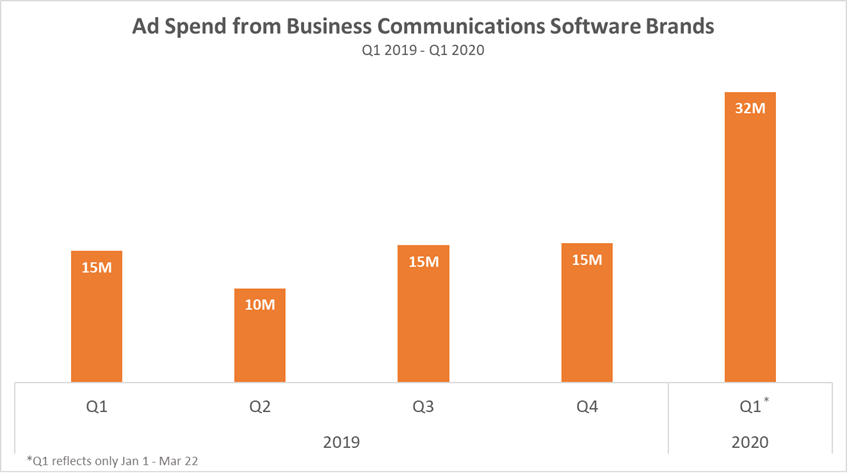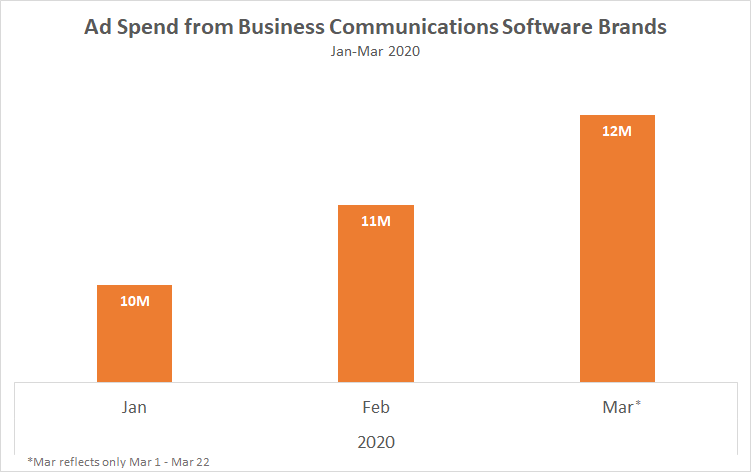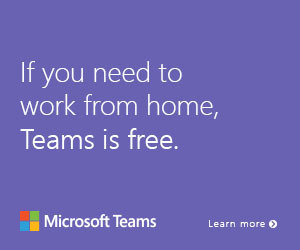The coronavirus crisis continues on. While many industries are struggling, video conferencing apps are experiencing an all new demand.
Remote work had already been a growing trend in the States before coronavirus broke out. But while the market as a whole plummeted, video conferencing tools performed extremely well.
This new level of remote work (and doing all facets of social life at home) has led to the rapid adoption of tools like Microsoft Teams, Zoom and Slack.
We take a look at how these companies are responding to a sudden increase in work-from-home employees and how companies have swiftly adjusted their advertising.
We encourage you to subscribe to our Blog for the latest data surrounding the advertising industry. We will provide daily updates as COVID-19 continues to make its mark on the US economy.

Video Conferencing Tools Make Huge Strides
When the crisis began to escalate earlier this month, companies — especially tech companies — began to implement work-from-home policies for their employees.
In early March, companies like Google and Microsoft seized the opportunity by offering free enterprise capabilities for a limited time, while Zoom offered its video conferencing tool for free to all affected schools.
Microsoft Teams, the largest advertiser YTD, has seen an additional 12M daily active users over the last 2 weeks. Its daily active user count (44 million) has doubled since November. Slack also reported a spike in users. Between February 1 to March 18, Slack saw 7,000 new paid users, compared to 5,000 in its previous fiscal quarter through January 31.
Microsoft Teams has responded by adding new features to make working from home easier. 93 of the Fortune 100 companies have said they have implemented Microsoft Teams.
This is not to mention that there has been an uptick in how many people are turning to video conferencing tools to maintain a social life. Younger generations are unequivocally prepared for social distancing: much of their lives are online anyways. College Zoom parties are now a thing.
Media Radar Insights: Video Conferencing Software Ad Spending
The jury’s still out on whether increased video conferencing is a trend that will slow down or if it’s here to stay long term, but we can look at the ad numbers in the meantime.
Communications software, companies like Zoom, GoMeeting, etc. have seen a significant spike in advertising dollars this quarter.
Top spenders YTD include:
- Microsoft Teams
- Fuze
- GoTo Meeting
- Grammarly
- Slack
- Zoom
Communications software brands spent more than double in Q1 this year than in Q1 (or any other quarter) of 2019.

When we focus on Q1 of this year we see that spend has gradually increased MoM, but with most spending in March.

This is impressive as the data was pulled with just over a week’s worth remaining in the quarter.
Recently we have seen these companies change their creatives to make reference to the situation. For example, Microsoft Teams is reminding users that if they “have to work from home” Teams is free.

Meanwhile, GoToMeeting’s latest tagline is “Power Through The Unexpected”

We will continue to watch video conferencing and remote work tools in the following months. We encourage you to subscribe to our blog for the latest updates.



